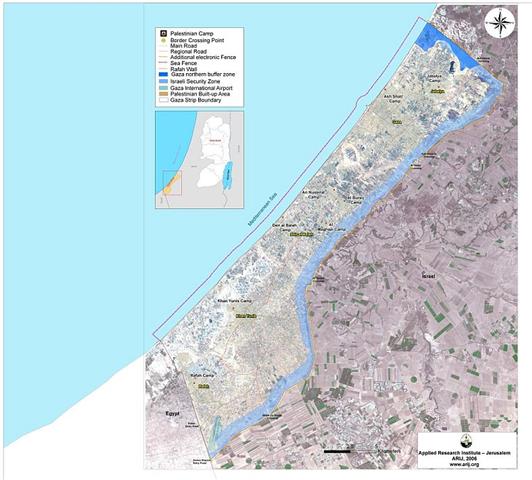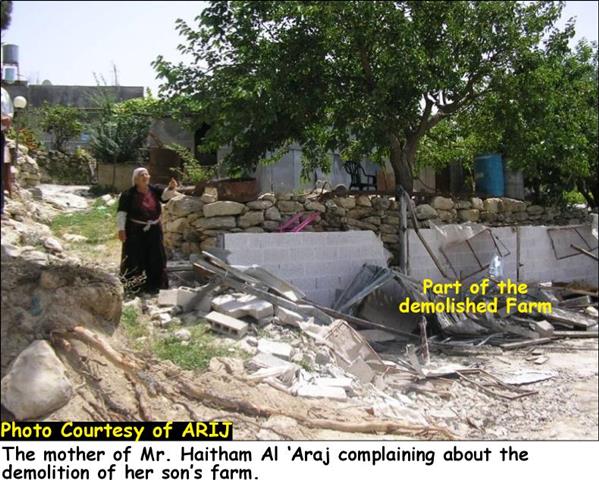Background
Geographically, Gaza Strip forms the westernmost portion of the Palestinian territories, having land borders with Egypt on the south-west and Israel on the north and east. On the west, it is bounded by the Mediterranean Sea.
The Strip's borders were originally defined by the armistice lines between Egypt and Israel after the 1948 Arab-Israeli War, which followed the dissolution of the British mandate over Palestine. Gaza was administered by Egypt until it was captured by Israel in the 1967 Six-Days War. In 1993, and after the Palestinian-Israeli agreements which known as the Oslo Accords, the majority of gaza came under limited Palestinian Authority control.
It is one of the most densely populated area on earth 362 km�², inhabited by 1,443,814 million residents. (From Summary Statistics, Gaza Strip, 1997-2015)
The Oslo Accord which officially called the Declaration of Principles on Interim Self-Government Arrangements or Declaration of Principles (DOP), were finalized in Oslo, Norway on August 20, 1993, and subsequently officially signed in Washington D.C. on September 13, 1993. The Accord calls for the withdrawal of Israeli forces from parts of the Gaza Strip and West Bank and affirm the Palestinian right to self-govern within those areas through the creation of the Palestinian Authority. Moreover, Palestinian rule would last for a five years interim period during which a permanent agreement would be negotiated (beginning not later than May 1996, after the Palestinian legislative Council election held in March 1996).
Until a final status accord was finalized, the West Bank and Gaza would be divided into three zones:
-
Area A – full control of the Palestinian Authority.
-
Area B – Palestinian civil control, Israeli military control.
-
Area C – full Israeli control.
Furthermore, the signed accord gave Israel authority over external security, and for internal security and public order of settlements and Israelis living in Gaza and the West Bank. Israeli military forces and civilians would be allowed to continue using roads freely within the Gaza Strip and the Jericho area.
The Disengagement Plan
Chronology of Events
-
The former Israeli Prime Minister Ariel Sharon first announced his vision of the Gaza disengagement plan at the 2004 Herzliya Conference. Failing to gain public support from senior ministers, Sharon agreed that the Likud party would hold a referendum on the plan prior to an Israeli cabinet vote. The referendum was held on May 2, 2004 and ended with 65% of the voters against the disengagement plan, despite most polls showing approximately 55% of Likud members supporting the plan before the referendum. Sharon himself announced that he accepted the Likud referendum results and would take time to consider his steps. He ordered Minister of Defense Shaul Mofaz to create an amended plan which Likud voters could accept.
-
On June 6, 2004, Sharon's government approved an amended disengagement plan
-
On September 14, 2004 the Israeli cabinet approved, by a 9-1 majority, plans to compensate settlers' agreed to depart the Gaza Strip voluntarily and to pay them suitable compensation.
-
On October 26, 2004 the Knesset gave preliminary approval for the plan with 67 for, 45 against, 7 abstentions, and 1 member absent.
-
On March 17, 2005 the IDF Southern Command issued a military order prohibiting Israeli citizens who do not reside in the Gaza Strip settlements from relocating to that area.
-
On August 31 , 2005 the Knesset voted to withdraw from the Gaza-Egypt border and to allow Egyptian deployment of border police along the demilitarized Egyptian side of the border, revising the previously-stated intent to maintain Israeli control of the border.
-
At midnight between August 14 and August 15, the Kissufim crossing was shut down, and the Gaza Strip became officially closed by Israelis. The voluntarily evacuation process continued after midnight August 17, for the settlers who asked for an extension for packing their things.
-
On August 17 the first forced evacuation of settlers, as part of the disengagement, started. About 14,000 Israeli soldiers and police personal prepared to forcibly evacuate settlers.
-
On August 22 Netzarim was peacefully evacuated by the Israeli military.
-
On September 7 the IDF announced that it plans to advance its full withdrawal from the Gaza Strip to September 12, pending Israeli cabinet approval.
-
On September 11 a ceremony was held when the last Israeli flag was lowered in the IDF's Gaza Strip divisional headquarters .All IDF soldiers pulled out of the strip in the following hours. The last soldier left the strip and the Kissufim gate was closed in the early morning of September 12. This completed the Israeli pullout from the Gaza Strip.
Post Disengagement Era
After the unilateral Israeli withdrawal from Gaza Strip, Israel is still control all of Gazaâ??s borders, including air and sea, as written in Sharonâ??s â??Disengagement Plan: General Outline,â?? issued on 18 April 2004 and again on 25 January 2005. â??Israel will guard and monitor the external land perimeter of the Gaza Strip, will continue to maintain exclusive authority in Gaza air space, and will continue to exercise security activity in the sea off the coast of the Gaza Strip.â??
In Gaza Strip there are four border terminals and one new trade passage (installed after the Israeli withdrawal). All of these Terminals fall under the complete control of Israel except Rafah Border Terminal.These Terminals are:
1. Rafah Border Terminal: located on the southwest of Gaza strip as a cross passage between the Gaza Strip and Egypt. The terminal was under the Israeli jurisdiction with partial Palestinian involvement up until January 2006, when Israel agreed after an American mediation to transfer the control of the terminal to the Palestinian Authority with a European supervision and censorship by the EU observers. After the Israeli withdrawal from the strip, the Israeli authorities demanded that goods passing through Rafah terminal to be re-routed to 'Kerem Shalom' trade passage for Israeli inspection, a round about and slow process that would be costly and highly inefficient.
2. Karni Border Terminal: It is a commercial crossing falls to the east of Gaza City on the demarcation line between Gaza Strip and Israel, and it is specified for commercial purposes, including transfer of vegetables to West Bank markets.
3. Erez Border Terminal: located north of the strip, and it functions as a crossing point for Palestinian workers, merchants, businessmen and VIP personals.
4. Sufia Border Terminal: located southeast to Khan Yunis and it is used to bring in building material from Israel to Gaza.
5. Kerem Shalom Trade Passage: It is a new established trade passage installed after the Israeli withdrawal from Gaza Strip, it is located to the south-east of the Gaza Strip, inside Israel, Kerem Shalom functions as a trade passage with limited and occasional use for humanitarian assistance coming from Egypt.
Israeli occupation forces are imprisoning nearly 1.5 million Palestinian residents of the Gaza Strip. Although the Strip is surrounded and completely cut off from the outside world. Sharonâ??s Plan states that â??there will be no basis for claiming that the Gaza Strip is occupied territory.â?? But international law confirms the opposite.
Economic activity is hindered by the Israeli procedures, closures and obstacles particularly after the withdrawal, while export and import remains under Israeli control. As included in the document, the Israelis will control â??the entry of workersâ?¦the entry and exit of goods between the Gaza Strip, West Bank, Israel, and abroadâ?¦the monetary regimeâ?¦tax and customsâ?¦postal and telecommunicationsâ?¦â??
After the 'Disengagement' Plan has been executed, Gaza residents are still subject to the effective control of the Israeli Army as it retains control over Gazaâ??s airspace, sea shore, and border crossings.
The Buffer Zone and the Security Zone
-
On December 12, 2005, the Israeli Army has declared a new 'buffer zone' north of Gaza where Palestinians will not be allowed to enter after 4pm. This buffer zone extends 9 kilometers along to the northern borderline of Gaza with Israel. The Israeli Army threw out leaflets written in Arabic which includes a map delimiting the zone.north of Gaza where Palestinians will not be allowed to enter after 4pm. This buffer zone extends kilometers along to the northern borderline of Gaza with Israel. The Israeli Army threw out leaflets written in Arabic which includes a map delimiting the zone.
The leaflets also warn the Palestinians that their lives will be threatened if they do not abide by the limits drawn on the map. The warning read: 'Anyone who does not comply with this warning is placing his or her life in immediate danger,'
The leaflet also read that the Israeli army will carry out intensive military actions in the northern areas of Gaza from areas where rockets are suspected fired on Israel.
Israel's move comes three months after its pull-out from the Gaza Strip.
-
The 'Security Zone' was first established by the Israeli Army back in 1996; along Gaza's borders with Israel. However, it was modified after the second Intifada in 2001 for security reasons, started north of the strip near â??Elie Sinai â??Settlement (evacuated in August 2005) and extends to the south of the Strip near â??Rafah Airportâ??. The Israeli established Security zone came on 61square kilometer (including the 8 kilometer northern buffer zone declared in December 2005), subsequently placing 17% of the Gaza Strip under direct control of the Israeli Army.
Conclusion:
Israel control over Gaza borders and17% of its territory continues to make Israel an occupying power, in fact as long as any of the lands captured by Israel during the 1967 war remains under its control makes Israeli an occupying power, which makes the unilateral disengagement to what it really is; a redeployment of forces and thus keep its legal responsibilities toward the occupied territory as it was prior to the disengagement. Under International Law [1907â??s Hague Regulations], the Fourth Geneva Convention, and international customary law â??an occupying power must uphold certain obligations to the people and land it occupies. An occupying power must maintain the status quo of occupied territory and may never unilaterally annex territory or transfer its civilian population into occupied territory. Moreover, the occupying powerâ??s activity in occupied territory must, be for the benefit of the population it occupies.
References:
The Palestinian Central Bureau of Statistics. (n.d.). Retrieved Apr. 17, 2006, from summary statistics, Gaza Strip, (1997-2015) Web site: http://www.pcbs.org/..
Prepared by
The Applied Research Institute – Jerusalem
ARIJ













